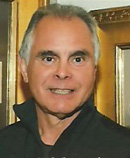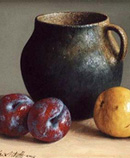
|
|
Finding silence in southwestern art Artist William Acheff developed a unique style reminiscent of the seventeenth-century Dutch still life painters, while using Native American objects as his subject matter. His work has been honored twice with the Prix de West award and is featured in galleries, exhibitions, and in the permanent collection of the Autry National Center of the American West. When Bill Acheff’s still life paintings were first shown in a gallery in Taos, New Mexico, a man told him, “I’m buying this because someday you’re going to be famous.” It wasn’t long before the artist became so well known that he even had imitators who were said to be “doing an Acheff” or “copying Acheff.” Today his work is shown regularly in top galleries throughout the U.S., and he is sought after for commissions from people who want an authentic William Acheff original. Acheff (the “ch” is pronounced “sh” as in chef) grew up in an environment quite different from that of the Southwestern Native American cultures whose artifacts he often paints. His family lived in the San Francisco Bay area near Stanford University, where his father worked at the Stanford Linear Accelerator. But one of his grandmothers was descended from Athabascans, the first people of the Alaska interior. For Bill, being part Indian meant he felt a resonance with Native materials. “It felt comfortable,” he says about painting beadwork, pottery, blankets, and related artifacts from the Pueblos and other Native American nations. Another grandparent was Dutch. Although Bill didn’t consciously plan a nod to this part of his heritage, he eventually decided to master realism like that of the seventeenth-century Dutch still life painters. He sought out their works in museums and in books to study the style. He was also fortunate to have high-quality art classes in high school and then to work closely with Italian artist Roberto Lupetti, painting in Lupetti’s studio and receiving regular feedback. By his mid-20s, when Acheff moved to New Mexico at the suggestion of a Los Angeles gallery owner, he was already an accomplished still life artist. The Southwestern Influence One day Acheff brought a painting to a gallery owner in Taos and asked, “What if I did something like this with Indian material? Would you be interested in it?” She encouraged him. So he began with the Southwestern theme, painting an Indian pot, a blanket, and corn. When he showed that piece and another in his first Taos show, they were popular, so he kept going. A little later, he launched a form that would be known as an Acheff. “I was painting some Indian material and looking at a pamphlet on Edward Curtis, who photographed Indians at the turn of the century. I thought, ‘I bet I could paint that photograph.’ I painted it and I had a pot and some corn or something in front of it. I thought it was a good way of extending a theme in a painting.” Now many of his works have a photo or painting within them. He was the first to try this form of realism: another work within a work. Transcending and Art Acheff’s paintings are not only accomplished in terms of the skill he brings to them but also seem infused with an extraordinary stillness. That stillness is something he experiences through his Transcendental Meditation (TM) practice. In 1973, his girlfriend at the time suggested they attend an introductory lecture on the Transcendental Meditation technique. “It’s a talk on this technique; they say it will help you paint better,” she told him. After learning, he said, “I knew my life was going to get better from that point on.” Not only did the TM practice enhance his personal life, it changed his art as well. He says, “This dealer I was selling to in LA said, ‘Man, your colors are something! Your colors have changed.’ I was using a more brilliant color palette, and he noticed it. He also said, ‘Your personality is different. You’re happier.’ I said, ‘It’s this meditation!’ I got a lot of people to start TM.” Creating art and transcending the moment seem to go together for Bill. “I’m very relaxed. When I’m painting, if people call, I have the phone right beside me so I don’t have to get up. They say ‘I’m sorry, I didn’t mean to wake you. Were you asleep?’ I say, ‘No, I’m painting.’” Acheff recalls one time when someone was observing him paint: “He said, ‘You were so calm and so peaceful.’ He wanted to know what that was. I said, ‘I started TM.’” When the TM-Sidhi program came out in the late 1970s, Acheff was among the first to learn. And this practice, too, has contributed to his work. Creative Strategies One of the creative strategies that Acheff has practiced over the years is to let a work rest before the final cycle of activity. He comments, “There’s a point when a painting is almost finished, like 98% finished, when I put the painting aside and maybe do something else. So I am walking by it in the studio for three or four days and I’m starting to look at the painting to see what it needs. I look at it with a fresh eye as a third person. I analyze it and think, ‘This should be a little darker here, I should do this,’ and so on. I try to make it completely finished. When it’s done, it talks back in the sense that it looks real to me or looks finished to me.” His primary creative strategy is to alternate meditation with activity. He says, “The unified field, or silence, permeates everything. If you’re bathed in that, you come out with it in activity. If you’re painting, that unity is going to be expressed in that painting.” Acheff suggests that if a painting is created from the superficial experience of an artist, the viewer’s experience remains superficial: “If it’s superficially perfect, it’s going to look mechanically perfect, but the inner substance won’t be there.” But if the painter has a deeper experience, then “The paintings have this silence. For the viewers, it’s like they are meditating. It attracts them somehow. They think maybe it’s because it’s so real, or this and that. But there’s the silence that grabs them.” Specifically, in his work with artifacts, Acheff's experience from his TM practice allows him to integrate diversity into a unified reality. “A lot of times I paint things that are not from the same tribe, but there is a unity in the spirit of the objects. So I paint that spirit.”
© Copyright 2012 Maharishi Foundation USA, a non-profit educational organization
|
|


